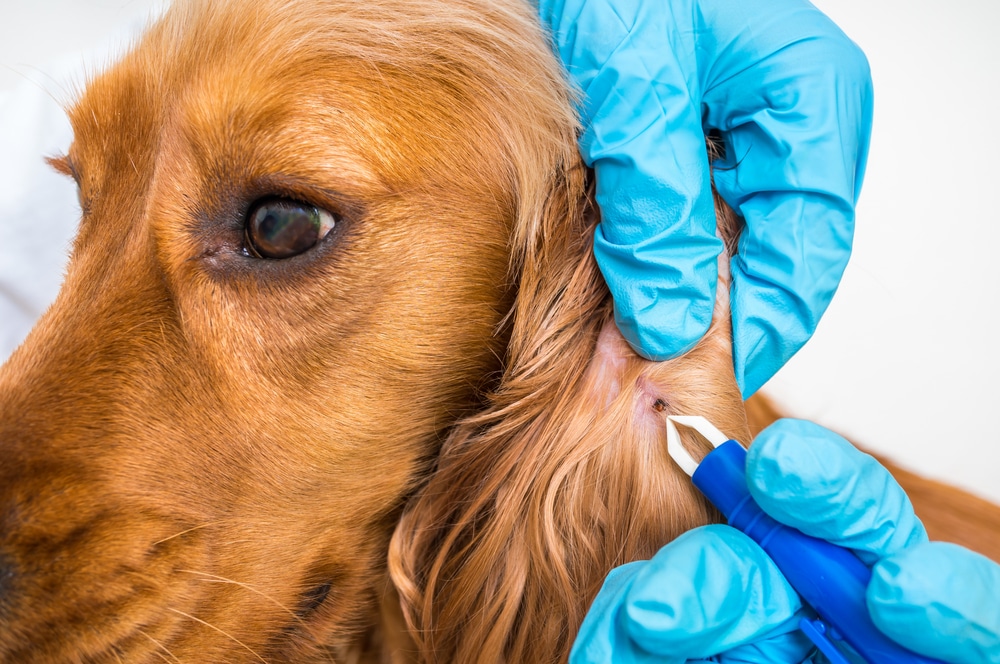Removing a tick from your dog is a simple process every dog owner can do. Ticks can carry a number of diseases, so removing one with alcohol as soon as you see it is the best way to prevent your dog get from getting sick. So, here’s how to remove a tick from a dog with alcohol.
To remove a tick from a dog with alcohol (which should only be done if you have no other options), you put on gloves and carefully dab the tick and surrounding area with alcohol. Then, grab the tick with tweezers and gently pull it off the dog so that it doesn’t break in two. Afterward, clean the alcohol off and apply an antibacterial ointment. Then, look for any signs of alcohol poisoning in your dog and schedule an appointment with your vet to check for any lingering issues from the tick or alcohol.
Table of Contents
- What Are Ticks?
- How Do Ticks Affect Your Dogs?
- Ways To Spot Ticks
- How To Remove A Tick From A Dog With Alcohol?
- Are There Other Ways To Remove A Tick From A Dog Besides Alcohol?
- How To Prevent Ticks On Dogs?
- Should I Ever Call A Vet If I See A Tick On My Dog?
- In Conclusion: How To Remove A Tick From A Dog With Alcohol?
What Are Ticks?

Ticks are small, spider-like parasites that suck blood from other animals. Ticks are common in grassland and, although active throughout the year, you’ll most likely see them between spring and autumn.
Unlike fleas, they don’t fly or jump. Instead, they climb or drop on your pet’s coat when they brush past whatever they’re stuck to. Ticks attach to your dog by inserting their mouth parts into your dog’s skin. Many ticks produce a sticky, gluelike substance that helps them to remain attached.
How Do Ticks Affect Your Dogs?
After attaching to your dog, ticks begin feeding on your dog’s blood. The places where ticks attach can become red and irritated. It gets even worse though because ticks can cause serious diseases such as Lyme disease, anaplasmosis, and ehrlichiosis.
Lyme disease can cause problems such as arthritis and swelling of your dog’s joints. Dogs infected by ehrlichiosis and anaplasmosis are likely to develop problems such as anemia, bleeding, lameness, respiratory failure, neurological problems, and swollen limbs.
Rarely, a tick will inject your dog with a toxin. This toxin causes weakness and even paralyzes the dog. Even though this is scary, once the tick is removed your dog will return to normal.
Ways To Spot Ticks
If your dog goes outside, try to make a habit of searching them when they come back in. Even a quick look can help. A tick is tiny, feels like a hard bump on your dog’s skin, and is typically dark brown or black. Ticks are usually found near a dog’s neck, head, ears, and in the creases under their legs.
Dogs may also lick and chew on the part of their body where the tick is. A dog shaking its head is another indicator because a tick may have latched onto its ear. For dogs with lots of hair, use a fine-toothed comb to help look.
How To Remove A Tick From A Dog With Alcohol?
It is recommended to talk to your vet before doing anything with dogs and alcohol since alcohol can be very toxic to dogs. If you have no other choice than to use alcohol to remove a tick from your dog, look for signs of alcohol poisoning such as vomiting, difficulty breathing, and loss of bodily control. Also, talk to your vet and see what they say too.
However, removing a tick from a dog is a simple process. Put on gloves and gently dab the tick and surrounding areas with the alcohol (remembering to clean off the alcohol later). Using tweezers, grab the tick as close to the skin where it is attached, without catching any skin, and slowly pull it off your dog so no parts are left behind.
When removing a tick, make sure not you don’t squeeze the tick’s body or leave the head in. Squeezing may crush the tick and release its fluid on your dog, increasing the chances of infection. Drown the tick in a jar of rubbing alcohol and apply an antibacterial ointment to the part of your dog the tick grabbed onto, like povidone-iodine solution or chlorhexidine.
Are There Other Ways To Remove A Tick From A Dog Besides Alcohol?
There is actually. There’s something called a tick removal hook, which is useful if you live in an area with lots of ticks.
There are several of these types of hooks. For example, there is the Tick Tornado or the Tick Twister. They’re easy to use too since all you have to do is put the prongs on either side of the tick and twist it on up.
But if you don’t have tweezers or any hooks around, some dental floss might also work. Simply tie some thread around the mouthpart area of the tick (as close to your dog’s skin as possible), then pull up and outwards. Pull slowly, so you don’t break the tick before it’s fully out of and off of your dog.
How To Prevent Ticks On Dogs?
If you and your dog spend any time outdoors, you should routinely check for ticks. A good way to prevent ticks from attaching to your dog is through the regular use of tick control products. Your veterinarian can give you advice on what to do and what to use to help.
You may also need to treat your yard for ticks if they continue to be a problem. This may also require the help of a professional.
Should I Ever Call A Vet If I See A Tick On My Dog?
If you find ticks on your dog they should be removed as soon as possible. Afterward, you should contact your veterinarian and take your pet to the clinic as soon as possible.
Suppose no clinical signs of tick paralysis are observed. In that case, it is still recommended to consult your veterinarian as signs of tick paralysis can develop even after the tick has been removed.
In Conclusion: How To Remove A Tick From A Dog With Alcohol?
So, it turns out, “How to remove a tick from the dog with alcohol’’ is easy to do. Your dog will thank you for continuing to keep it safe even while having fun outdoors.
So, do you have any tips for removing ticks from dogs? Does your dog often get ticks? Let us know your thoughts and why in the comments below!
